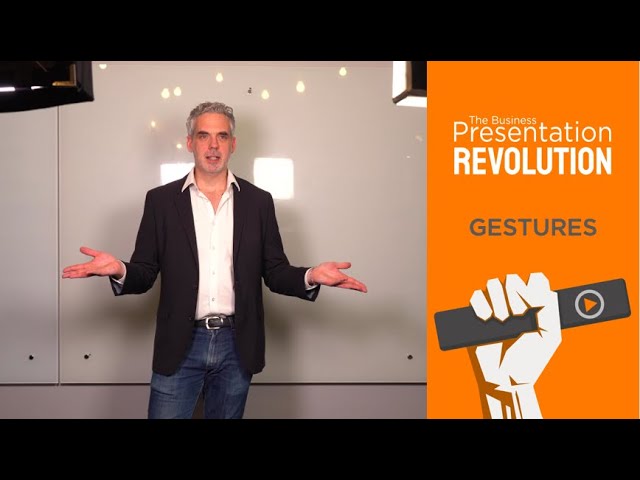
Transcript
Welcome to The Business Presentation Revolution! I’m here with my colleague Michael Rickwood who’s going to be sharing with us what to do with our bodies while presenting.
So Michael, our clients regularly ask us: “What do I do with my body, my hands, my face while presenting?” What do you tell your clients?
Rose, what you’re talking about is gestures and we all need to use them on stage, but to be better at gestures it’s good to know about the four different types of gestures that we can use to be more effective communicators on stage.
There are four types of gestures?
OK, what’s the first one? The first ones are called illustrators. Now these are the gestures that you use while you’re speaking and these are great for three reasons. The first reason is that it helps people to absorb better what you’re saying. The next reason is because it helps you to channel stress. And the third reason is it helps you to remember your words as you’re speaking.
Okay, so there are some that we’re using while we’re talking like the Italians do. What’s the second type of gesture?
The second type of gestures - on a cultural note - are called emblems. These are the gestures that you’re using when you don’t speak or don’t have any words, so gestures that really speak for themselves. So for example Rose you’re from the USA. In the USA you have specific nonverbal gestures like that which will work right, like thumbs up or hello goodbye.
Not every gesture works in every country so that’s something to think about. That’s really important if you’re doing international business. One thing might mean something very positive in one country such as our OK sign in America, and that could mean something very different in another country. So with intercultural communication it’s important to have a little coaching on that beforehand.
All right, what’s our next gesture Michael?
So now I want to talk about the face and what we call affect displays. Now the face is very expressive and this is very useful for example with storytelling: we want to tell about a past experience. The face is very important. How can we make the most of it?
OK, I love that and something that it makes me think of is congruence and how important it is that our facial expressions agree with what we’re doing with our body. So if you’re telling a positive message, having that effect of a positive expression - a smile etc - and if you’re delivering hard news, you might not want to be smiling with a teethy grin.
Right, kind of like this. But facial expressions also vary from culture to culture. In Latin America and Europe you’re going to be much more expressive than for example in Asia.
Anything else that we should know in terms of gesture types?
Well there’s one more that I haven’t spoken about and these are regulators. These are the gestures that you use in order to tell the audience what to do. They’re called regulators so it’s simply a case of: sit down, stand up, OK everybody please move to the other room. So these gestures are really about interacting and giving orders to the audience and I suppose something a teacher might use quite a lot.
OK right such as… bring it down.
OK, perfect!
Michael, now we know what to do with our body, is there anything we should avoid?
Yes, there are certain gestures that we do that reflect or tell the audience about our negative inner states. These are called parasitical gestures and you should try to avoid them. Things such as playing with your hair or your clothes, wringing your hands together or or anything that’s giving those negative feelings away. You can get rid of them by just either working with a coach or just filming yourself and watching it back over to see what you need to eliminate. Pacing unnecessarily is another thing.
Excellent stuff, thank you Michael. Now we know what to do with our bodies, what to avoid, is there any last tip to share with our viewers?
Absolutely. When in doubt, relax. Audiences love that.
I love it!
So, three things to remember:
One, there are different types of gestures to use. Experiment. Two, avoid parasitical gestures, doing things unconsciously. Three, when in doubt, relax.
Thank you so much for joining The Business Presentation Revolution! We look forward to seeing you next time.
If you like what you saw, subscribe to us on iTunes and YouTube and follow us on LinkedIn.